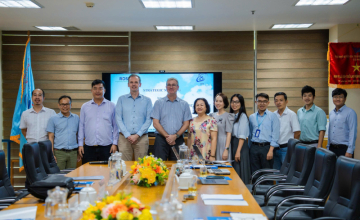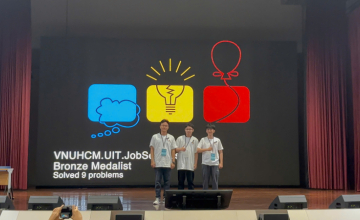Student researchers: Vo Chon Chanh (20521122) - Le Thi Lan Anh (20521067) - Duong Thi Ngoc Anh (20521062)
Content:
Problem Statement
According to the definition of Brunsden and Cruden, soil erosion is the downhill movement of debris, rocks, or soil materials under the influence of gravity. It occurs when the driving force exceeds the resistance due to the instability of natural slopes or rocks. Natural slopes can become unstable due to natural and human factors, including improper land use, loss of vegetation cover, heavy and prolonged rainfall, weathering and strong cracking of rocks, erosion of channels and riverbanks, earthquakes, and urbanization without planning (Woldearegay, 2013; Wubalem and Meten, 2020).
Riverbank erosion is the result of various impacts, from geological factors, topography, hydrology, climate to human factors. With the influence of the tidal regime, the study area is influenced by the uneven semi-diurnal tide regime of the East Sea, with a large tidal range of about 2-4 meters. With such tidal and tidal range, the tidal wave propagation speed is very fast, creating a large flow velocity, especially at the river mouth, causing erosion of the seabed.
Furthermore, due to the influence of the coastline structure and sediment deposition, with the coastline structure mainly consisting of mud and fine sand, under the influence of waves and wind, the surface structure of the coastline will be broken if there is no surface vegetation cover. Due to the very fine grain size, most of the broken shoreline materials will be converted into suspended silt and sand, easily carried away by waves and currents to other locations. Therefore, the coastline is vulnerable to damage without vegetation cover or mangrove forests for protection.
Erosion occurs seriously in many places around the world. In Southeast Asia, the Mekong Delta of Vietnam has experienced and is experiencing erosion phenomena due to the dual impact of climate change, rising sea levels; water exploitation from upstream; the impact of the internal development of the region. In recent years, the erosion of river and canal systems, coastal erosion, has been occurring in most provinces and cities in the region, with increasingly serious and complex levels, increasing both in scope and intensity.
The purpose of this study is to investigate the extent of erosion and sedimentation around the area of rivers and coastlines affecting the Mekong Delta. At the same time, identify influencing factors through quantitative methods. The use of mainly quantitative methods revolves around statistical analysis, correlation, and regression to understand the causes of soil erosion. These methods are highly accurate due to mathematical foundations that help identify influencing factors more easily than qualitative methods.
Through this research, a machine learning model is created through learning with various methods to predict erosion points to establish an erosion prediction map in the Mekong Delta region. The area we are studying is illustrated in Figure 1.
Methodology
Vector map objects (areas, lines, points) will be extracted using tools in QGIS, then distances and erosion levels will be calculated. After that, the attributes will be normalized and exported to an Excel format for data mining analysis.
In this study, we use two quantitative methods: statistics and correlation analysis to find the factors influencing erosion areas. The data will be divided into two parts (80:20), training and testing data will be randomly selected based on statistical factors.
Additionally, vector maps will be rasterized to facilitate overlaying maps and calculations on vectors to create prediction maps.
The data will be fed into training and a machine learning model will be created to predict erosion points and generate a prediction map of erosion levels. The experimental method is shown in Figure 2.
Conclusion
In this study, we focused on solving the main problem of predicting and mapping erosion and sedimentation in the Mekong Delta through quantitative analysis. We also created a highly accurate erosion prediction model with a Logistic Regression machine learning model achieving an accuracy of 0.89 with 9 attributes and classification into 6 levels of erosion and sedimentation.
We addressed challenges related to distance calculations in coordinates and reality, land classification, and accessing map information. However, there are still limitations in erosion data in the Mekong Delta area due to the limited amount of data, resulting in inaccuracies in predicting erosion locations. In the future, we will continue to collect more erosion points and enhance the dataset to improve the accuracy of the prediction map.
Sincerely
Detailed Information: https://fit.uit.edu.vn/index.php/tin-tuc/goc-hoc-tap/6598-du-doan-cac-diem-sat-lo-va-boi-lang-tren-dong-bang-song-cuu-long-bang-cac-mo-hinh-hoc-may
Đông Xanh - Media Collaborator, University of Information
English version: Phan Huy Hoang







